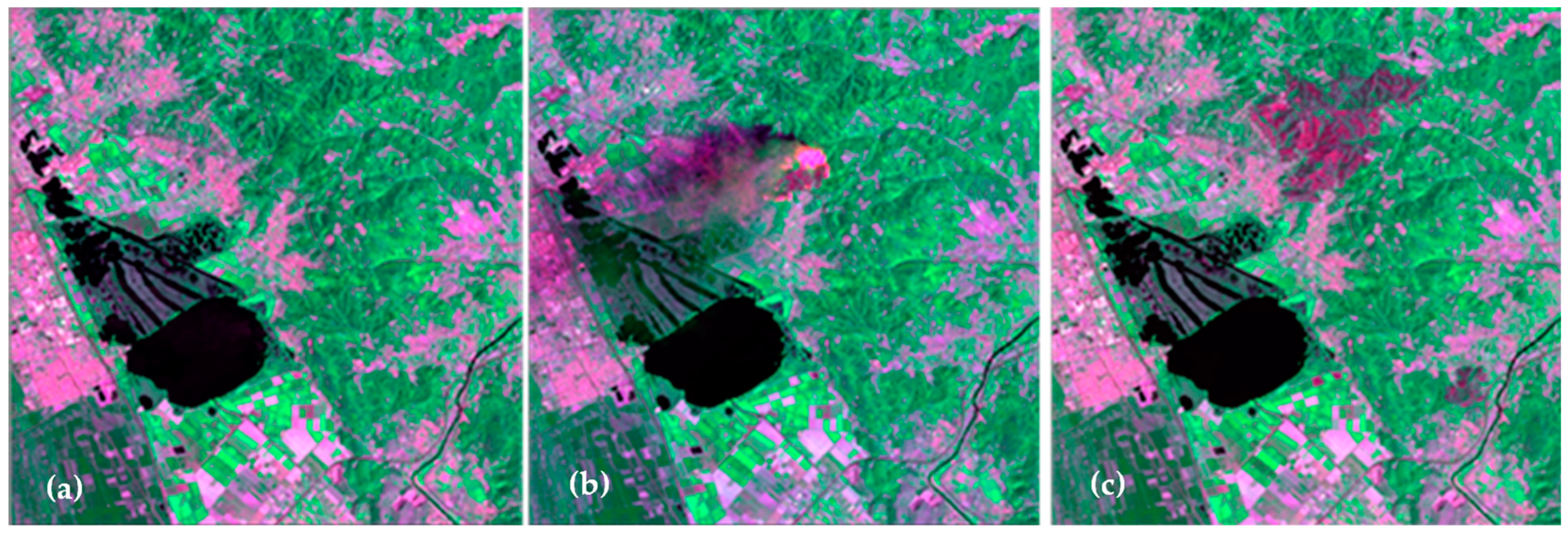The Impact of Spatial Resolution on Active Fire Monitoring Using Multispectral Satellite Imagery †
Abstract
:1. Introduction
2. Study Area
3. Results
4. Conclusions
Author Contributions
Funding
Institutional Review Board Statement
Informed Consent Statement
Data Availability Statement
Conflicts of Interest
References
- Dozier, J. A Method for Satellite Identification of Surface Temperature Fields of Subpixel Resolution. Remote Sens. Environ. 1981, 11, 221–229. [Google Scholar] [CrossRef]
- Matson, M.; Dozier, J. Identification of Subresolution High Temperature Sources Using a Thermal IR Sensor. Photogramm. Eng. Remote Sens. 1981, 47, 1311–1318. [Google Scholar]
- Li, Z.; Kaufman, Y.J.; Ichoku, C.; Fraser, R.; Trishchenko, A.; Giglio, L.; Jin, J.; Yu, X. A Review of AVHRR-based Active Fire Deection Algorithms: Principles, Limitations and Reccomandations. In Global and Regional Vegetation Fire Monitoring from Space: Planning a Coordinated International Effort; Ahern, F.J., Goldammer, J.G., Justice, C.O., Eds.; SPB Academic Publishing: The Hague, The Netherlands, 2001; pp. 199–225. [Google Scholar]
- Kaufman, Y.J.; Justice, C.O.; Flynn, L.P.; Kendall, J.D.; Prins, E.M.; Giglio, L.; Ward, D.E.; Menzel, P.W.; Setzer, A.W. Potential Global Fire Monitoring from EOS-MODIS. J. Geophys. Res. 1998, 103, 32215–32238. [Google Scholar] [CrossRef]
- Giglio, L.; Descloitres, J.; Justice, O.; Kaufman, Y.J. An Enhanced Contextual Fire Detection Algorithm for MODIS. Remote Sens. Environ. 2003, 87, 273–282. [Google Scholar] [CrossRef]
- Bandinelli, G.; Carlà, R. Fire Detection by Analysis of Infrared Satellite Imagery 1992. In Proceedings of the Advanced Infrared Technology and Applications Conference, Florence, Italy, 13–14 April 1992; pp. 415–428. [Google Scholar]
- Tang, H.; Li, Z.L. Quantitative Remote Sensing in Thermal Infrared: Theory and Applications; Springer Remote Sensing/Photogrammetry; Springer: Berlin/Heidelberg, Germany, 2014. [Google Scholar] [CrossRef]
- LANDSAT 8 BANDS. Available online: https://landsat.gsfc.nasa.gov/satellites/landsat-8/landsat-8-bands/ (accessed on 22 September 2023).
- Goessmann, F.; Maier, S.W.; Lynch, J. Improved Spatial Resolution of Fire Detection with MODIS Using the 2.1 µm Channel. In Innovations in Remote Sensing and Photogrammetry; Springer: Berlin/Heidelberg, Germany, 2009; pp. 183–189. [Google Scholar]
- Maier, S.W. Using the predictive power of a kernel driven BRDF model to map clouds and burnt areas. In Proceedings of the 4th International Workshop on Multiangular Measurements and Models, Sydney, Australia, 20–24 March 2006. [Google Scholar]



Disclaimer/Publisher’s Note: The statements, opinions and data contained in all publications are solely those of the individual author(s) and contributor(s) and not of MDPI and/or the editor(s). MDPI and/or the editor(s) disclaim responsibility for any injury to people or property resulting from any ideas, methods, instructions or products referred to in the content. |
© 2023 by the authors. Licensee MDPI, Basel, Switzerland. This article is an open access article distributed under the terms and conditions of the Creative Commons Attribution (CC BY) license (https://creativecommons.org/licenses/by/4.0/).
Share and Cite
Gonnelli, A.; Baronti, S.; Carlà, R.; Raimondi, V. The Impact of Spatial Resolution on Active Fire Monitoring Using Multispectral Satellite Imagery. Eng. Proc. 2023, 51, 30. https://doi.org/10.3390/engproc2023051030
Gonnelli A, Baronti S, Carlà R, Raimondi V. The Impact of Spatial Resolution on Active Fire Monitoring Using Multispectral Satellite Imagery. Engineering Proceedings. 2023; 51(1):30. https://doi.org/10.3390/engproc2023051030
Chicago/Turabian StyleGonnelli, Andrea, Stefano Baronti, Roberto Carlà, and Valentina Raimondi. 2023. "The Impact of Spatial Resolution on Active Fire Monitoring Using Multispectral Satellite Imagery" Engineering Proceedings 51, no. 1: 30. https://doi.org/10.3390/engproc2023051030
APA StyleGonnelli, A., Baronti, S., Carlà, R., & Raimondi, V. (2023). The Impact of Spatial Resolution on Active Fire Monitoring Using Multispectral Satellite Imagery. Engineering Proceedings, 51(1), 30. https://doi.org/10.3390/engproc2023051030





